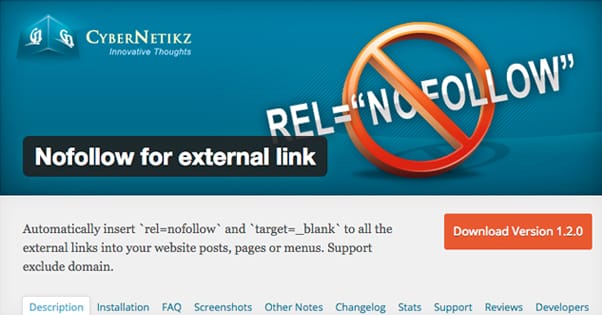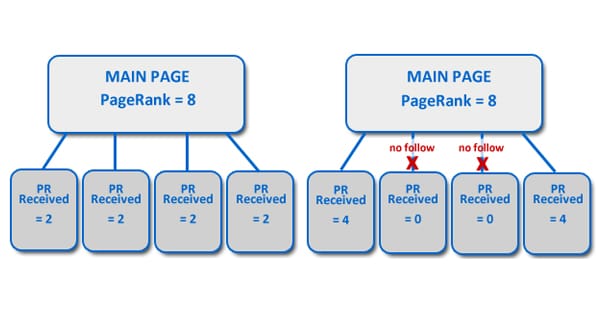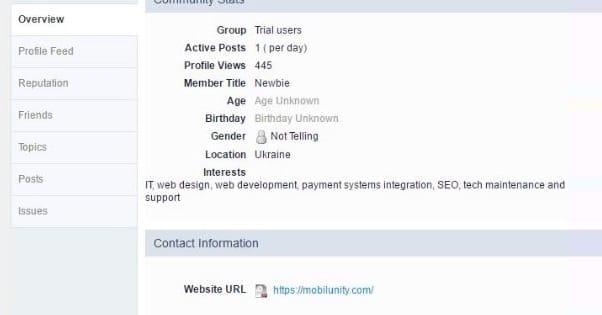Should You Nofollow All External Links in Your Blog Posts?
Published by Kenny Novak • Search Engine Optimization • Posted August 10, 2017 ContentPowered.com
ContentPowered.com
The idea of nofollowing all the external links on your site tends to come from two different places. In one case, it stems from a faulty understanding of “link juice” and how that whole system works. In the other, it comes from a sort of overkill “better safe than sorry” perspective.
Should you nofollow every external link on your site? No. You can, if you really want, but it won’t be effective, and might get you flagged as a site trying to abuse an old spam technique.
Link Juice and PageRank Sculpting
Link juice is the visualization of the value of a link passing into and out of a site through various holes, represented by links.
The thinking went like this. Your site has link juice coming in from every site that’s linking to you. It also is losing link juice from every link you point out to another site. Before the nofollow attribute was added, you simply had to deal with it. Once nofollow hit, though, you had a new method of manipulating this link juice.
Imagine if you had all of this value flowing into your site, but you clogged all of the holes. All of the links pointing out to other sites would be nofollowed, while all the internal links would feed back upon themselves, making a system with input but no output.
You would think that this a great technique for retaining value and growing your site. You don’t lose anything, you keep gaining from incoming links, and you grow faster than if you were linking out with followed links.
A more advanced version of this visualization involves numbers. Your page, say, is worth 6 PageRank. You link out to three websites; two others and one of your own. Each of those gets 2 of your 6 PageRank, leaving your page with nothing. Well, not nothing; 2 of that PageRank is feeding back into your site somewhere else.
You decide that 2 is not enough, so you nofollow one of the links to an external site. This means the 6 PageRank is split in two, instead of in three, so each link is now worth 3 PageRank. Your page still loses 6, but instead of 2 cycling back in, 3 is.
The idea was, if you nofollowed every external link, all PageRank from your site cycles back into your site via internal links.
This all worked for a while, but Google very quickly discovered people were using nofollow to sculpt their pagerank and subvert the value of links throughout the web. A web without valuable links undermines the basic foundation of Google’s algorithm, so they couldn’t allow it to stand. They changed how PageRank interacts with nofollowed links. This method no longer works.
Now, today, let’s take the numerical experiment. You have a page worth a nebulous concept of 6, and you have three links pointing out. Each of those links is passing along 2 PageRank, ignoring all of the variables about relative site value and relevance of content.
You decide to nofollow the two external links, so your 6 PageRank flows back into your site through the one internal link. You measure – though no such tool to perform such a measurement exists – and find that the link is still just passing 2 link juices.
Modern Google link juice monitoring takes the total value of the page and divides it up amongst all the links on the page, regardless of what position or attributes those links have. If you nofollow a link, no link juice flows through that link, but the link still exists. It still counts for dividing up PageRank, and still decreases the amount of PageRank that flows out through each other link. PageRank sculpting died that day, in 2009.
So why not just remove any link you don’t want dividing up your PageRank? Well, you can do that, and probably should. That’s why when I use “www.example.com” on my sites, I explicitly don’t make it a hyperlink. Google might be smart enough to identify that it’s an example link and not something I mean to include in the value calculation, but they might not, and that’s not a risk I want to take.
What if you go all the way, and just remove all external links? You can, but chances are it’s more likely to hurt you than help you. Three reasons why:
- It’s unnatural link sculpting. This is one of Google’s sort of “catch-all” penalties they can issue for just about anything they don’t like. They have an absolutely massive sample size – basically the whole internet – so they know what a natural link profile is likely to look like, and they know what kind of actions people might take to try to game the system. Even if your actions don’t match a specific negative profile, they can see that you’re outside the norm, take a closer look, and determine that you should be penalized for it.
- External links are known to be valuable to the linking site. This doesn’t mean you can just throw a dozen links on every page and have value roll in, but it IS an implicit hint from Google that linking out is better than not doing so.
- Users will feel less value on the site. If I’m reading a page and someone states a fact, I’d like to see a source for that fact. If someone is reporting news, I want to know the source for that news. Links are huge for informational purposes, and even if I don’t explicitly notice that they’re gone, I’ll still feel a lack of options when reading a site with no external links.
The fact is, you need external links, and you need to use them naturally. So how and when should you use nofollow if you want to be in top compliance?
Properly Using NoFollow on External Links
So, nofollow is a powerful attribute to add to links, but when and how should you use it? You don’t want to nofollow good links, because it doesn’t help you and can actually hurt you a little in your overall site value. You likewise don’t want to leave in value-passing links to spam sites, because then you’re sending value to a black hole.
Rule #1: Think of a link as a vote of confidence. Links pass value by default, unless you remove that value. Even then, there’s some intimations that they might be able to pass value regardless, through implied links.
Ignoring all other rules and guidelines, use this one and your best judgment. If you think the site you’re linking to is worth receiving your vote, the link can be followed. If you don’t think the site is good enough, nofollow the link. A few links to good sites that are nofollowed isn’t a bad thing. I’ve seen sites that deliberately nofollow links to their competitors, just out of a minor bit of spite. There’s nothing wrong with that as far as Google is concerned, as long as you don’t over-do it with an overly broad definition of competitor.
So what kinds of links should you nofollow, according to Google and according to SEO professionals and their experiments?
Links that were paid for. Any sort of link that you received payment for should be nofollowed. This includes people who pay to take up a guest contributor slot on your site. This includes people who give you a product to review in exchange for a link to their product pages. This includes people who try to bribe you with a direct contribution or a guaranteed purchase. This even includes “payments” of other links, if such a direct form of collusion is offered.
Links that stem from a commercial relationship. This one is just an expansive catch-all to cover the above. A commercial relationship can include things beyond just paying for a post, however. Links from business partners might qualify. Links from other sponsors of an event you run. Anything where there’s a potentially reciprocal profit going on might be better nofollowed than not.
Of course, in reality, people want to use links to benefit their sponsors and partners. It’s often fine to let a few of these through. The problem comes if you’re getting these sponsorships in exchange for links, or you’re running some kind of link scheme with product purchasing as an incentive. There are a ton of different variations to these scenarios, so just ask yourself if Google or an impartial third party would consider you to be accepting bribes or payment in exchange for link value. If so, nofollow the links to be on the safe side.
Links generated by users. Any time someone who is not you or another page admin is able to add a link to your site, you should nofollow that link. Unless you vet every single link coming through your page, you don’t want someone with no oversight able to create a vote in your name.
The most common instances of this are web forums and blog comment sections. Web forums tend to be blanket nofollowed to try to avoid spam, though spambots will still happily spam a forum open to guest posting or cheap registration. Blog comments also usually should be nofollowed, as it discourages the worst of the spam.
That said, if you’re willing to personally vet and approve any link that comes in through your comments, you can leave them followed. You just have to then make sure that you stay on top of this moderation and make absolutely certain that the links you end up posting are approved. Google isn’t going to penalize you for using a comments system that includes followed links. In fact, if you want to further encourage links, you can always use a comment system that centers around link distribution, like CommentLuv.
If you’re not willing to use a plugin that includes moderation, or perform the moderation yourself, you need to make sure those kinds of submissions are automatically nofollowed. You can always include a good link to the same page later as a source if you like it enough.
Links to sites that are low quality. This is the big one. Any website you aren’t sure of the quality, or that you’re pretty sure is low quality, go ahead and nofollow the link. Again, always remember that your link is a way of passing value. If you wouldn’t want to introduce this website to your website grandparents at website thanksgiving, you shouldn’t give it your vote of confidence. This includes spam sites, sites with user content you might not want to vouch for – like low quality web communities – and brand new sites in your niche that you might not know if it’s valuable or not just yet.
Links that are irrelevant. If I was going to link to a shoe store as an example of a store page, I would probably nofollow that link. The reasoning here is a little different though. See, when a link comes into your site from a completely irrelevant page, it has next to no value. Irrelevant links can even be detrimental, since Google might assume that they’re coming from purchased link schemes or private blog networks.
Rather than make the site deal with later asking me to remove or nofollow a link they deem valueless to their own SEO, I just nofollow them by default. This way they don’t have to worry about the links, and I can still use them as an example without having to go through a tedious process of screenshotting and formatting images to use instead of a link.
Links to system pages that the average user doesn’t need to see. The normal user might be interested to see your privacy policy or your About page or some other system page, but they don’t need to show up in web search. However, you can’t just noindex them, because then Google won’t be able to see them at all. Google definitely wants you to have a privacy policy page, for example, but there’s no reason for it to show up in most queries. Therefore, you can noindex the links pointing to it.
If you follow these guidelines, you should be able to use nofollow appropriately the majority of the time. You might nofollow a few good links or leave in a few bad links, but that’s natural. A few links won’t hurt you. It’s only when you’re abusing them one way or another that you can find a penalty waiting for you.









